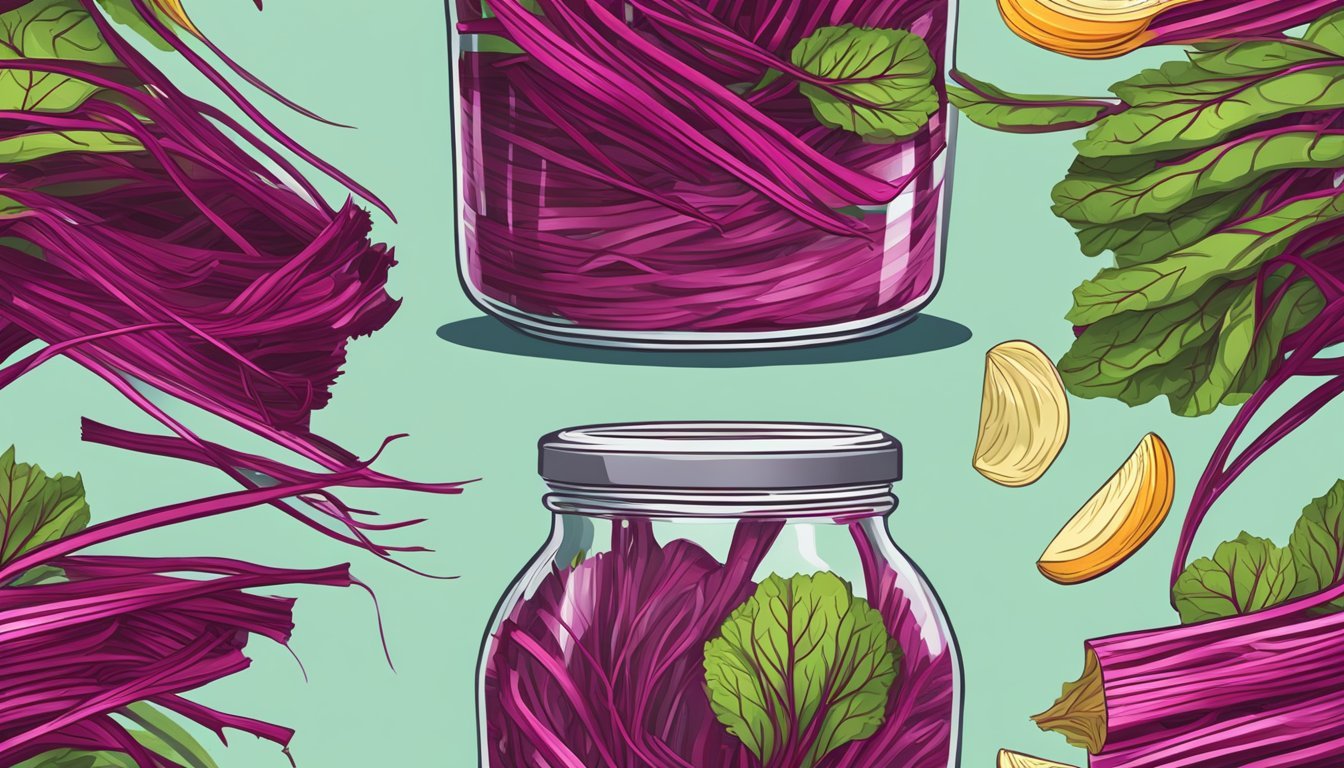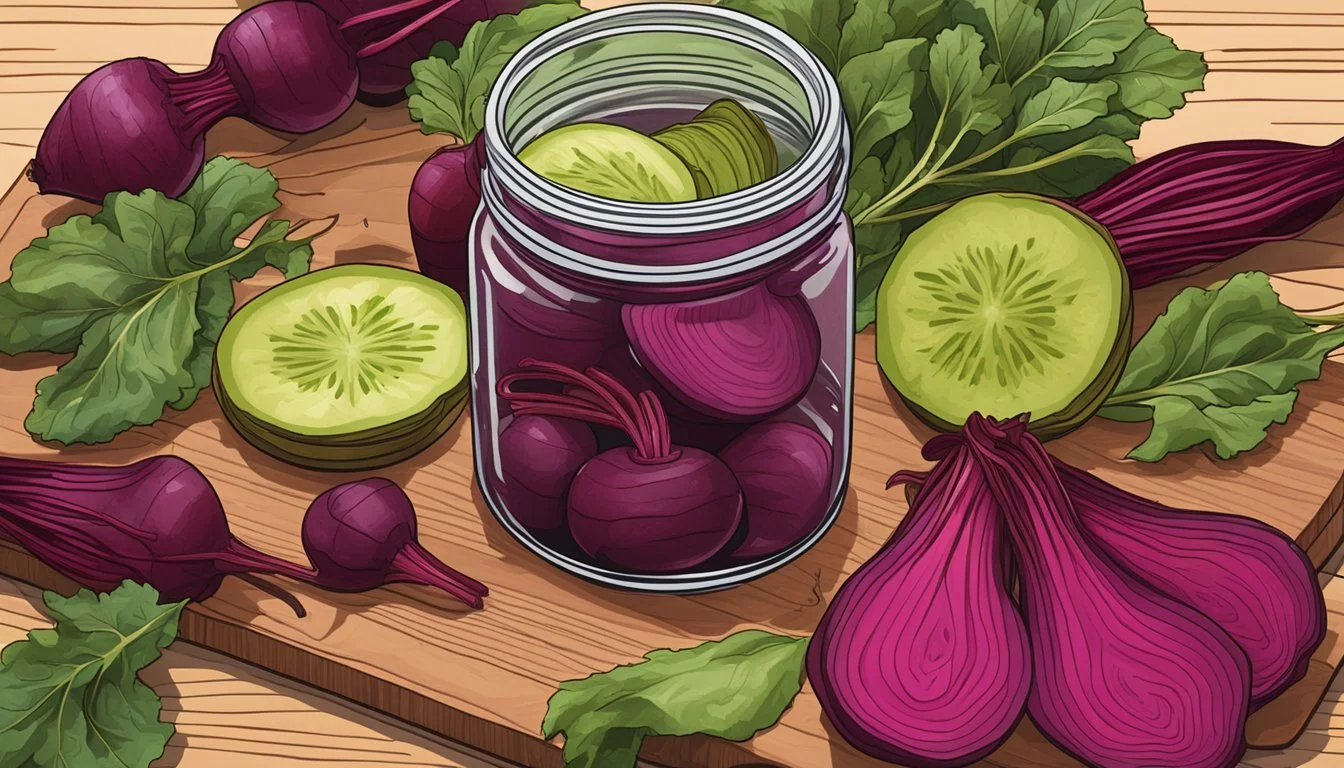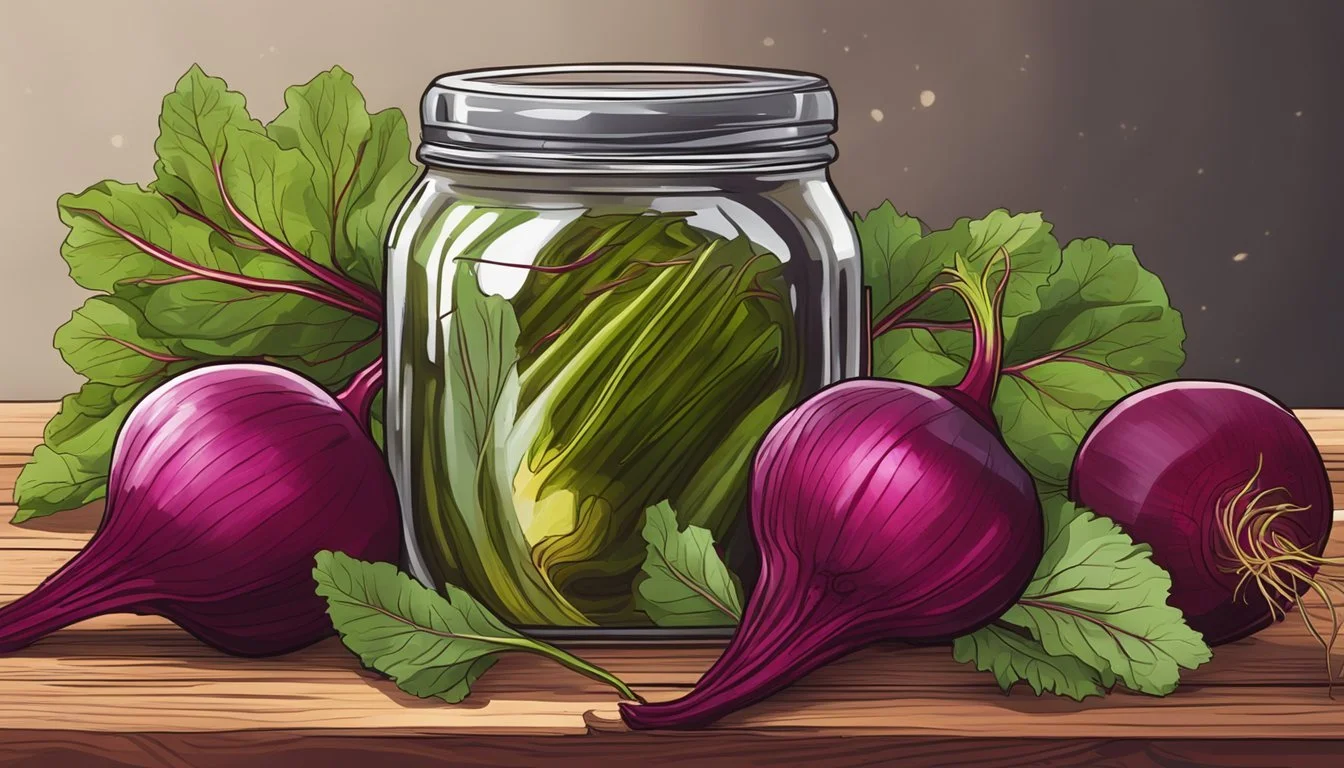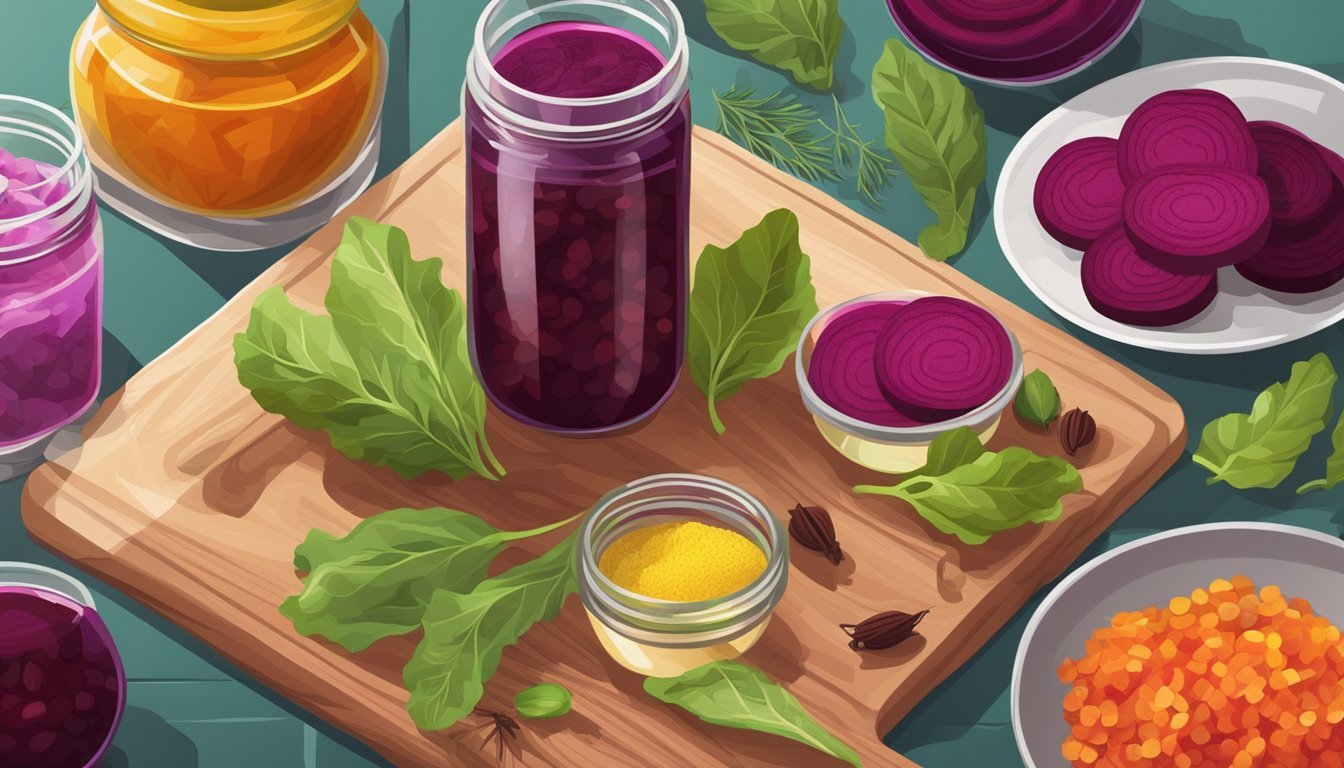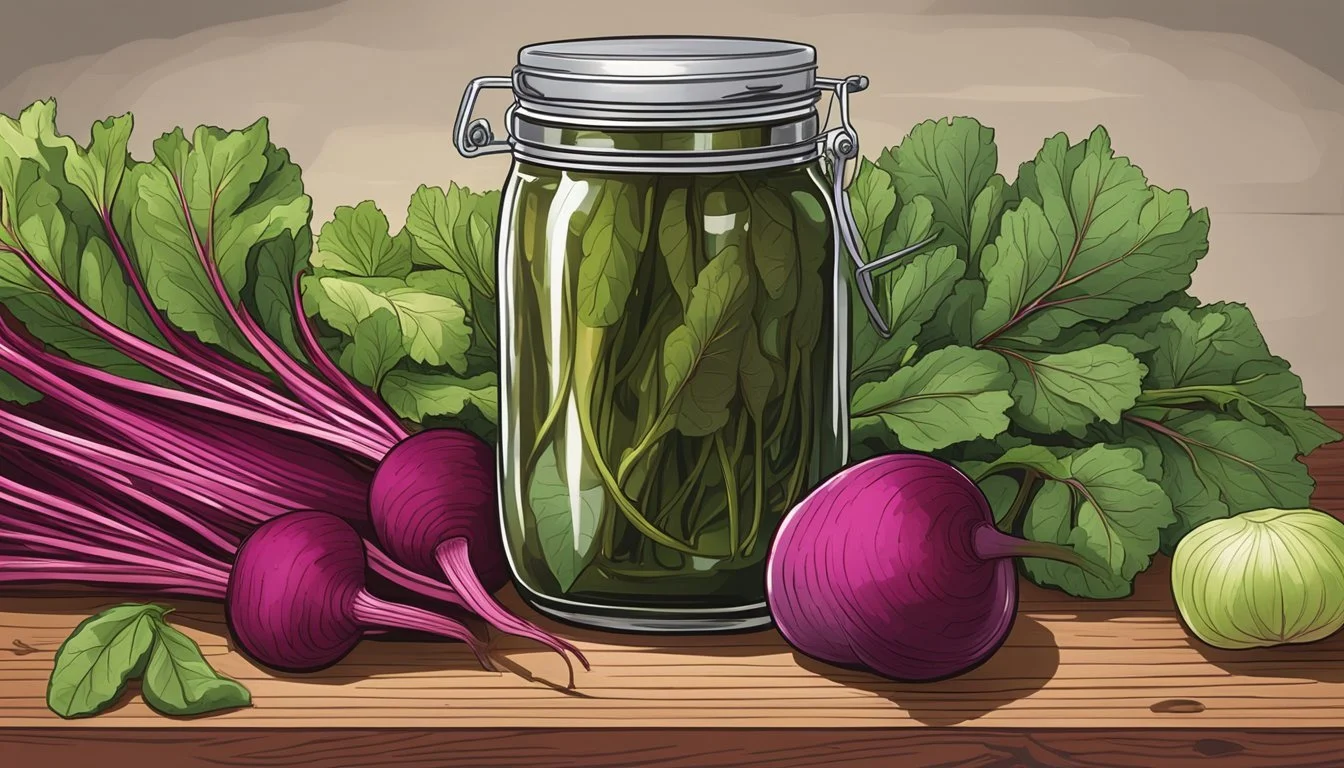Beet Stem Pickles
A Colorful, Crunchy Garnish for Savory Dishes
Beet stem pickles are an inventive way to utilize the entire beet plant, cutting down on waste and adding a vibrant, crunchy condiment to the culinary palette. Too often, the stems of beets are discarded, seen as merely the tough conduits to the more commonly consumed beetroot. However, these stems are not only edible, but they can also be transformed into delicious pickles, offering a combination of earthy and tangy flavors along with a satisfying crunch. This preservation method not only extends the shelf life of what might otherwise be composted material but elevates it into a gourmet garnish or snack.
The process of pickling beet stems involves a simple yet flavorful brine. This typically includes vinegar, which acts as the pickling agent, along with sugar or honey to balance the acidity. To further enhance the taste, a blend of spices and seasonings such as salt, pepper, and herbs like rosemary or cilantro can be added. This mixture is heated until the sweeteners and salt are fully dissolved, ensuring a consistent flavor profile throughout the pickled stems.
These tangy treats are versatile and serve as a colorful addition to a variety of dishes. Beet stem pickles can be sprinkled over salads for an acidic bite, used as a condiment for sandwiches and burgers, or simply enjoyed on their own as a unique side dish. Not only do beet stem pickles make for an eye-catching and tasty treat, but they also exemplify a move towards sustainable cooking practices by highlighting the value in parts of vegetables that are commonly overlooked.
History and Cultural Significance
Pickling, a method of food preservation that imbues vegetables with a delightful tang, has deep historical roots. Evidence points to ancient Mesopotamia as the birthplace of this culinary technique, which was swiftly adopted by various cultures. Beet stem pickles emerge as a vibrant and crunchy variant, incorporating the often-overlooked stems of beetroot.
Beetroot, a plant revered since antiquity, was cultivated by the Greeks around 300 BC. Initially, the focus was on the leafy greens, and the roots were offered to Apollo, symbolizing their high value. Romans later discovered the culinary and medicinal potential of the beet itself.
Pickles have transcended mere sustenance, occupying a significant place in culture and tradition. They denote prosperity and well-being in many societies, and folklore often portrays them with mystical qualities. The process of canning further popularized pickling by simplifying the means to preserve various foods, including beet stems, for year-round use.
The quick pickle method is a modern adaptation that offers a swift alternative to traditional canning, perfect for preserving beet stems. This method has facilitated the integration of pickled beet stems as a garnish, adding a pop of color and texture to dishes.
Culture Significance Method Greek Sacred offering Primary focus on leaves Roman Medicinal use Whole plant utilization Modern Garnish Quick pickle for crunchy texture
Incorporating these tangy accouterments, not only enhances the gustatory experience but also serves as a nod to a practice deeply rooted in human history. The tradition of pickling beet stems continues to be a testament to the ingenuity of preserving the bounty of the earth.
Health Benefits
Incorporating beet stem pickles into one's diet offers specific nutritional benefits, supports digestive health, and contributes to reducing food waste.
Nutritional Components
Beet and chard stems, often discarded during meal preparation, are rich in fiber and antioxidants, making them a nutritious choice for pickling. Here are key nutrients found in these stem pickles:
Fiber: Essential for digestive health, it helps to regulate bowel movements.
Antioxidants: Protect cells from damage by free radicals and supports overall health.
Minerals: A variety of minerals like potassium, calcium, and magnesium contribute to muscle function and blood pressure regulation.
Digestive Health
The high fiber content in beet stem pickles enhances digestive health by promoting gut regularity and function. Additionally, the probiotic content created during the fermentation process aids in balancing the microbiota in the gut, enhancing digestive wellness and potentially boosting the immune system.
Reducing Food Waste
By turning beet and chard stems into pickles, one efficiently utilizes parts of the vegetables that would otherwise contribute to food waste. Pickling these stems not only extends their shelf life but also provides a creative way to enjoy the full nutritional value of the plant.
Ingredients and Substitutions
This section will guide the reader through the necessary ingredients for making beet stem pickles and offer practical substitutions for customization.
Primary Ingredients
Beet Stems: Crunchy and robust, usually leftovers from beets, are the core ingredient.
Vinegar: Acts as the pickling agent. Common varieties include apple cider vinegar for a milder tang and red wine vinegar for a deeper flavor.
Sugar: Balances the acidity. Can be regular granulated sugar or a sugar substitute if desired.
Salt: Essential for flavor and preservation. Use non-iodized salt to prevent cloudiness.
Water: Often combined with vinegar to create the pickling solution.
Flavor Enhancers
Onion: Sliced or chopped, it contributes a mellow sweetness.
Mustard Seeds: Add a spicy kick and texture to the brine.
Coriander Seeds: Provide a lemony, floral note.
Celery Seeds: Contribute to a subtle, bitter complexity.
Dill: Offers a fresh, herbal undertone.
More exotic spices such as anise, fennel seed, caraway seeds, and thyme can be added for unique flavor profiles.
Substitution Tips
Substitutions can be made to suit personal preferences and dietary requirements. Here are a few:
Original Ingredient Substitutions Sugar Honey, maple syrup, or a sugar-free alternative like stevia. Apple Cider Vinegar Red wine vinegar, white vinegar, or rice vinegar for different tang levels. Mustard Seeds A pinch of ground mustard or a mustard spread if seeds are not available. Coriander Seeds Cilantro leaves can be a fresh alternative, though the flavor will be different. Dill Thyme, fennel fronds, or tarragon as an alternative herb choice.
It's important to maintain the ratios of vinegar, water, sugar, and salt to ensure proper preservation and flavor balance when pickling beet stems.
Preparation Techniques
The transformation of beet stems into a tangy garnish requires careful preparation, precise cutting, and an understanding of pickling principles. Below are the techniques needed to create pickled beet stems that are not only colorful but also offer a crunchy texture and a burst of flavor.
Cleaning and Cutting
Cleaning beet stems is crucial to ensure that any dirt and debris are removed before pickling. One should thoroughly wash the stems under cold running water—gentle scrubbing may be necessary to remove all impurities. After cleaning, the stems are cut, typically on the bias into 1/4-inch slices for even pickling and an appealing presentation. It's important to use sharp knives to ensure clean and consistent cuts.
Creating the Pickling Liquid
Pickling liquid forms the base flavor of the pickled beet stems. The essential ingredients include vinegar, water, sugar, and salt. Most recipes will use a medium saucepan to bring the vinegar mixture to a boil, ensuring the sugar and salt are fully dissolved. Spices such as peppercorns, rosemary, or even a dash of sriracha can be added for complexity. The ratios of vinegar to water vary, with some opting for a stronger vinegar taste while others prefer a milder pickling liquid.
Packing and Sealing
Once the beet stems are cut and the pickling liquid is prepared, the next step is the proper packing of the stems into canning jars. It's important to pack the beet stems tightly but without crushing them, allowing the hot brine to permeate evenly through the mixture. Leaving proper headspace at the top of the jar is vital to ensure a seal can be formed, and to allow for expansion. Once the stems are in place, the hot brine is poured over the stems, taking care to release any trapped air bubbles. After sealing the airtight jars, they are often allowed to cool before being refrigerated, optimizing the pickling process and ensuring the stems retain their crunch.
Pickling and Canning Methods
The methods of pickling and canning beet stems involve either a quick pickle process for refrigerator storage or a more traditional water bath canning for extended shelf life. These techniques transform the firm, colorful stems into a crunchy, tangy garnish.
Refrigerator Pickling
For those who prefer a quick and easy method, refrigerator pickling is ideal. The basic process involves:
Slicing beet stems into ¼-inch pieces.
Boiling a pickling liquid, which typically includes vinegar, water, sugar or honey, and seasonings.
Pouring the hot brine over the beet stems placed in a clean jar, ensuring the stems are fully submerged.
Once cooled, sealing the jar and storing it in the refrigerator.
This process allows the beet stems to absorb the flavors within 20 minutes, though they continue to develop over time. Refrigerated pickles are usually ready to consume after sitting for 24 hours and can be stored in the refrigerator for several weeks.
Water Bath Canning
For long-term preservation, water bath canning is the appropriate technique. It involves:
Sterilizing canning jars and lids by boiling them in water.
Packing the prepared beet stems into the hot jars.
Filling the jars with a hot vinegar solution leaving the recommended headspace, usually 1/2 inch.
Removing air bubbles by gently tapping the jars or using a small tool.
Wiping the jar rims to ensure a proper seal.
Processing filled jars in a boiling water bath for a specified time, often 30 minutes for pints.
Cooling the jars undisturbed to allow seals to form properly.
Canned beet stems should be stored in a cool, dark place and can last for up to a year when properly sealed and stored. This method ensures that the beet stems remain safe for consumption over a longer period, and it locks in the flavor and crunchiness of the freshly pickled produce.
Serving and Pairing Suggestions
Beet stem pickles add vibrant color and a satisfying crunch to various dishes, enhancing them with a unique blend of sweet and tangy flavors. Their versatility makes them a standout topping or ingredient in both appetizer and snack options.
As a Garnish
Salads: A handful of pickled beet stems contributes a delightful crunch and bright hues.
Charcuterie (What wine goes well with charcuterie?) Boards: They bring a pop of color and a tangy zing, complementing a variety of cheeses and cured meats (What wine goes well with cured meats?).
Tacos: A scattering on top adds a crunchy, flavorful dimension that contrasts beautifully with soft fillings.
Incorporating Into Meals
Grain Bowls: Pickled beet stems can serve as an acidic component, providing a flavorful balance to hearty bowls.
Sandwiches: Inserted within layers, they give sandwiches an additional tangy crunch, elevating the overall texture and taste.
Pizza: When used as a topping after baking, their crunchiness and flavor accentuate the gooeyness of the cheese.
Storage and Shelf Life
When it comes to preserving the vibrancy and crunch of beet stem pickles, storage plays a pivotal role. These pickles should be stored in an airtight container to prevent them from exposure to air, which can lead to spoilage. The ideal storage vessel is a glass jar with a tight-sealing lid.
For optimal freshness, beet stem pickles should be kept in the refrigerator. This cool environment maintains the pickles' crispness and extends their shelf life. Upon refrigeration, the pickles will generally last up to 6 months. It is important to note that the shelf life can vary depending on the acidity and the specific pickling process used.
If one desires to keep the pickles for an extended period, freezing is a viable option. It should be noted that while freezing can last for up to a year, it may slightly alter the texture of the pickles.
Heed these storage tips to ensure longevity:
Airtight Containers: Always seal the jar properly after use.
Refrigerate: The colder temperature slows down the deterioration process.
Keep it Cool: Even before opening, store the jars in a cool, dark place.
The safety of consuming pickled beets can be ascertained by reheating them to an internal temperature of 165°F (74°C). Observing proper storage techniques will not only extend the shelf life of beet stem pickles but also maintain their gourmet quality as a crunchy, colorful garnish.
Economic and Budget Considerations
Making beet stem pickles is a cost-effective way to utilize the often-discarded parts of beets, offering both financial and environmental benefits. When individuals buy beets for their roots, they often overlook the stems, which can be transformed into a delicious garnish with minimal additional investment.
Cost of Ingredients: The ingredients for pickling beet stems are inexpensive and many are common pantry items:
Vinegar: A key pickling agent, often found at low cost when bought in bulk.
Sugar or Honey: Used for flavor balance; bulk purchases can reduce the cost further.
Salt: Inexpensive and a staple in most households.
Spices and Herbs: While fresh herbs can add to the cost, dried variants provide a budget-friendly alternative without compromising flavor.
By pickling, consumers extend the shelf life of beet stems, lowering food waste and maximizing their grocery investments, making it an economical practice.
Cost-Effectiveness of Homemade vs. Store-Bought: Homemade pickles are generally more budget-friendly than artisanal or store-bought counterparts. Consider the following comparison:
Item Homemade Pickled Beet Stems Store-Bought Pickled Goods Cost per batch Typically under $2 Often $5 or more Customization Full control over ingredients Limited to available flavors Yield Can be scaled to preference Fixed quantity
In summary, the process of pickling beet stems is economical as it employs affordable ingredients and transforms a potential waste product into a palette-enticing condiment. This practice promotes both fiscal prudence and sustainable food use.

